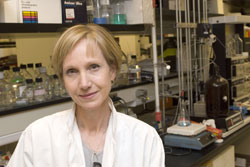Median Age Of Survival For Canadians With Cystic Fibrosis Surpasses 50 Years Of Age

 In the 1980s, life expectancy for persons with cystic fibrosis (CF) was just 12 years in the US, and around 20 in Canada. However, the median age of survival for Canadian CF patients continues on an upward trend, and is currently estimated to be 50.9 years of age — or two and a half times what it was 30 years ago, and among the highest in the world. This milestone was recently announced at the North American Cystic Fibrosis Conference in Atlanta, Georgia.
In the 1980s, life expectancy for persons with cystic fibrosis (CF) was just 12 years in the US, and around 20 in Canada. However, the median age of survival for Canadian CF patients continues on an upward trend, and is currently estimated to be 50.9 years of age — or two and a half times what it was 30 years ago, and among the highest in the world. This milestone was recently announced at the North American Cystic Fibrosis Conference in Atlanta, Georgia.
Based on the most recent Canadian Cystic Fibrosis Registry data, which track clinical trends and insights regarding Canada’s CF population, the median age of survival reflects dedicated work of CF researchers and clinicians as it breaks the half century mark. The data are collected from all 42 CF clinics located across Canada.
“The median age of survival in Canada for CF patients has now passed 50 years of age and shows tremendous progress in the fight against cystic fibrosis,” says Dr. Anne Stephenson, Director of the CF Registry. “We hope the Canadian Cystic Fibrosis Registry will continue to enhance knowledge and highlight key trends that will lead to improved CF research and treatments.”
Cystic Fibrosis Canada has published an annual report on Canadian patient registry data for more than 40 years, and it has played an invaluable role in helping to improve the quality and length of life of Canadians with cystic fibrosis. The Registry is an important resource for CF clinicians to help monitor and identify emerging patterns in health outcomes of CF patients, as well as for researchers searching for a cure or control for this devastating disease.
“This positive step forward demonstrates our enhanced focus on leading in quality improvement and excelling in CF care through our investments in research, care and advocacy,” says Ken Chan, Vice President, Advocacy, Research, and Healthcare at Cystic Fibrosis Canada. “The Registry continues to benchmark the tremendous strides we are making, and would not be possible without the funding support from our donors.”
[adrotate group=”1″]
Cystic fibrosis is the most common fatal genetic disease affecting Canadian children and young adults — a multi-system disease that affects mainly the lungs and the digestive system. In the lungs, where the effects are most devastating, a build-up of thick mucus causes severe respiratory problems. Mucus and protein also build up in the digestive tract, making it difficult to digest and absorb nutrients from food. As improved therapies have helped to address the malnutrition issues, ultimately most deaths related to cystic fibrosis are due to lung disease. There is no cure.
However, discovery of the gene that causes cystic fibrosis — CFTR — the first disease-causing gene to be identified and at the time of discovery, at Toronto’s Hospital For Sick Children (“SickKids”) 25 years ago last month, is touted as one of the most significant advances in the history of human genetics, and is understood to be one of the most significant breakthroughs in human genetics that has not only impacted lives of children and young adults with CF, but also paved the way for what is now known as individualized medicine.
 “Finding the gene opened the door to unprecedented knowledge of the disease. After its discovery we were able to study and understand how the protein made by the CFTR gene worked and what happened when it didn’t,” says Dr. Christine Bear Senior Scientist and Co-Director of the CF Centre at SickKids . “Once we figured this out, therapy that targeted defects caused by CF gene mutations could begin.”
“Finding the gene opened the door to unprecedented knowledge of the disease. After its discovery we were able to study and understand how the protein made by the CFTR gene worked and what happened when it didn’t,” says Dr. Christine Bear Senior Scientist and Co-Director of the CF Centre at SickKids . “Once we figured this out, therapy that targeted defects caused by CF gene mutations could begin.”
“We are at a new frontier of discovery for CF patients,” Dr. Bear notes in a Hospital For Sick Children release. “Over the past decade there has been tremendous progress with regards to therapy discovery conducted using generic cells induced to possess a particular CF mutant protein. These workhorse cell cultures were then used to identify the types of chemical compounds that can repair the defect caused by that specific mutation. However, there were limitations since these cells did not exactly mimic the cell in the lungs, liver or pancreas of CF patients. While this approach led to the discovery of one drug called KALYDECO, we believe that a new discovery strategy is needed during the upcoming 10 years to find the next generation of therapies effective in treating all CF patients.”
KALYDECO, the drug referred to by Dr. Bear, is exclusively indicated to treat only a relatively small sub-minority of what is an already relatively small number of cystic fibrosis cases overall who have at least one copy of the G551D mutation in the cystic fibrosis transmembrane conductance regulator (CFTR) gene. The CF prevalence rate in general in the most vulnerable ethnic group, Caucasians, is just one in every 2,500 births. Consequently, since the proportion of cystic fibrosis cases positive for the G551D mutation in the CFTR gene is very low, and only few CF patients eligible to use KALYDECO, economies of scale associated with sales of more widely-prescribed drugs don’t obtain with KALYDECO, keeping the cost per patient high.
The release notes that the CF story at SickKids has always been one of collaboration. The gene discovery was a partnership between SickKids and the University of Michigan; the creation of the CF mutation database is an international collaboration; and the most recently, the pharmaceutical and philanthropic communities and SickKids came together to develop KALYDECO.
Cystic Fibrosis Canada provides nearly $2 million in funding each year to CF clinics through the Clinic Incentive Grants program to support efforts in providing data to the Registry.
To learn more about the Canadian CF Registry, visit
https://www.cysticfibrosis.ca
Sources:
Cystic Fibrosis Canada
Hospital For Sick Children (Toronto)
Image Credits:
Hospital For Sick Children (Toronto)







